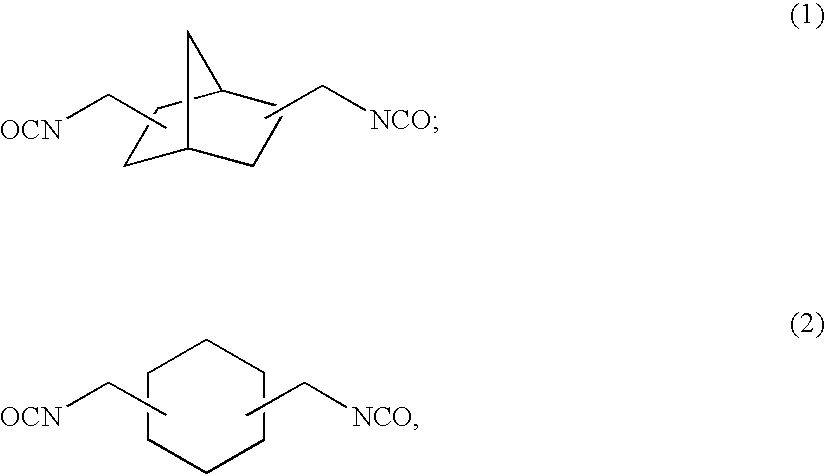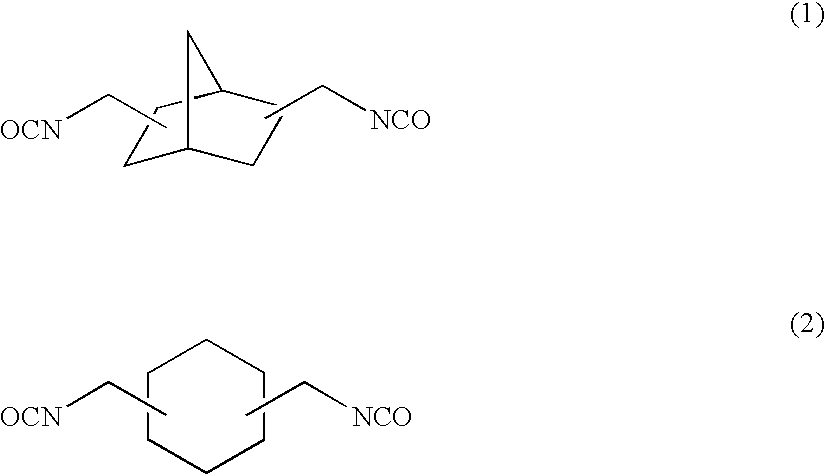Polythiourethane-based polymerizable composition and optical resin obtained from the same
a polythiourethane and composition technology, applied in the field of polymerizable compositions, resins, optical components, can solve the problems of deterioration of impact resistance of lenses and cracks on coats, and achieve the effects of improving tintability, and reducing the number of cracks
- Summary
- Abstract
- Description
- Claims
- Application Information
AI Technical Summary
Benefits of technology
Problems solved by technology
Method used
Image
Examples
example 1
[0158]To 57.38 g of 2,5(6)-bis(isocyanatomethyl)-bicyclo[2.2.1]heptane, 0.10 g of dibutyltin chloride as the curing catalyst, 0.25 g of internal mold release agent (product name: Zelec UN), and 0.05 g of UV absorbing agent (product name: Viosorb 583) were mixed and dissolved at 20° C., to give a homogeneous solution. To this homogeneous solution, 7.52 g of 1,4-butanediol was added, and the mixed solution was stirred for 20 minutes at 30° C., then cooled down to 20° C., and further stirred for 30 minutes. Thereafter, 35.10 g of 4-mercaptomethyl-1,8-dimercapto-3,6-dithiaoctane was added thereto to be mixed and dissolved therein.
[0159]After degasifying the homogenous solution at 600 Pa for 1 hour, the resultant was filtered through a 1 μm PTFE made filter, and then charged into a mold assembled from a pair of glass molds and tape. The mold was placed in an oven and slowly heated from a temperature of 25° C. to 120° C. over 20 hours, and the polymerization was carried out. After complet...
example 2
[0161]To 54.22 g of 2,5(6)-bis(isocyanatomethyl)-bicyclo[2.2.1]heptane, 0.10 g of dibutyltin chloride as the curing catalyst, 0.25 g of internal mold release agent (product name: Zelec UN), and 0.05 g of UV absorbing agent (product name: Viosorb 583) were mixed and dissolved at 20° C., to give a homogeneous solution. To this homogeneous solution, 7.89 g of triethylene glycol was added, and the mixed solution was stirred for 20 minutes at 30° C., then cooled down to 20° C., and further stirred for 30 minutes. Thereafter, 37.89 g of 4-mercaptomethyl-1,8-dimercapto-3,6-dithiaoctane was added thereto to be mixed and dissolved therein.
[0162]After degasifying the homogenous solution at 600 Pa for 1 hour, the resultant was filtered through a 1 μm PTFE made filter, and then charged into a mold assembled from a pair of glass molds and tape. The mold was placed in an oven and slowly heated from a temperature of 25° C. to 120° C. over 20 hours and the polymerization was carried out. After comp...
example 3
[0164]To 54.22 g of 2,5(6)-bis(isocyanatomethyl)-bicyclo[2.2.1]heptane, 0.10 g of dibutyltin chloride as the curing catalyst, 0.25 g of internal mold release agent (product name: Zelec UN), and 0.05 g of UV absorbing agent (product name: Viosorb 583) were mixed and dissolved at 20° C., to give a homogeneous solution. To this homogeneous solution, 7.89 g of triethylene glycol and 37.89 g of 4-mercaptomethyl-1,8-dimercapto-3,6-dithiaoctane were added at once, and these were mixed and dissolved in a water bath at 20° C. over 30 minutes to give a homogeneous solution.
[0165]After degasifying the homogenous solution at 600 Pa for 1 hour, the resultant was filtered through a 1 μm PTFE made filter, and then charged into a mold assembled from a pair of glass molds and tape. The mold was placed in an oven and slowly heated from a temperature of 25° C. to 120° C. over 20 hours and the polymerization was carried out. After completing the polymerization, the mold was taken out from the oven, and...
PUM
| Property | Measurement | Unit |
|---|---|---|
| molar ratio | aaaaa | aaaaa |
| heat resistance | aaaaa | aaaaa |
| refractive index | aaaaa | aaaaa |
Abstract
Description
Claims
Application Information
 Login to View More
Login to View More - R&D
- Intellectual Property
- Life Sciences
- Materials
- Tech Scout
- Unparalleled Data Quality
- Higher Quality Content
- 60% Fewer Hallucinations
Browse by: Latest US Patents, China's latest patents, Technical Efficacy Thesaurus, Application Domain, Technology Topic, Popular Technical Reports.
© 2025 PatSnap. All rights reserved.Legal|Privacy policy|Modern Slavery Act Transparency Statement|Sitemap|About US| Contact US: help@patsnap.com



